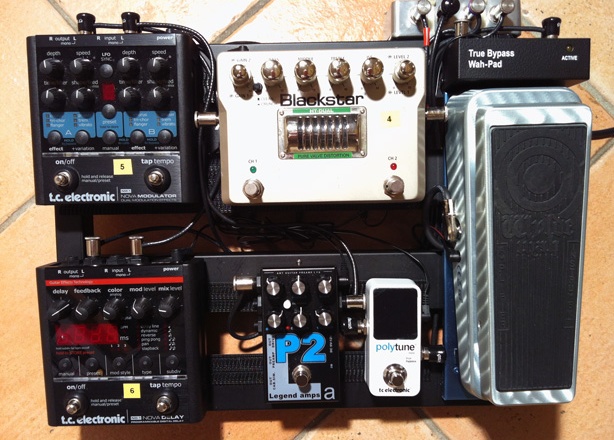This article is about the Mini Board I proposed in my Pedalboards 2013 – Is 3 overkill? article. This board is intended for gigs where I’m running into a clean amp, eg at a “supplied backline” gig, but can also be used for jams, rehearsals, songwriting and even with my main rig.
This is the first version of the grab-n-go board, put together for gigs which don’t allow us to bring our own backline. Yep, it’s quite common here in Switzerland, especially for Fête de la Musique style events, for the stage to already set up with drums and backline. To save time between changeovers, it’s better for the organisers when everyone can share the same amps. Not necessarily better for us, the players, but not much we can do. Hence the need for a portable pedalboard incorporating distortion, boost, delay and some modulation effects which I can run into the front of a clean amp, eg Fender Twin.
What you see here is a Pedaltrain Junior, powered by a Cioks AC-10 (to supply the high current needed by the Blackstar HT-Dual), loaded with the following (in signal chain order):
Loop 1 (Guitar to Amp input)
- TC Electronic Polytune Mini – this is a great little tuner, with an easy to read display and stable digital readout which doesn’t bounce all over the place when fine-tuning. I use it in normal chromatic mode, rather than in “polytune” mode, as I just feel more comfortable tuning one string at a time. The Polytune also acts as a master “mute” for the pedalboard.
- G-Lab True Bypass Wah Pad with Dunlop Zakk Wylde Wah – the G-Lab is an excellent piece of kit giving instant on/off just by placing my foot on the pedal or lifting it off again. The Zakk Wylde Wah is mounted to the G-Lab using an EWS Wah Mounting Board. If I have one complaint it is that the two together add up a fair bit weight to haul around.
- AMT Legend Series P2 – these Russian designed and manufactured pedals have created quite a stir due to their sound, clean channel, and 3 outputs for different applications. The P2 emulates the Peavey 5150 and creates a crushingly huge, modern rock grind. Having never owned an original 5150 I’ve no idea how authentic the P2 is, but it sounds great.
- Blackstar HT-Dual – this has been my go-to distortion for years now (mine is an early “series 1” version), and can dial in anything from Marshall style heavy crunch to more American voiced modern rock territory. The twin-channel configuration makes it very versatile and ideal for use in a live situation. Its power requirements are huge, however, hence the need to use a Cioks AC-10 to power it and everything else on the board.
Loop 2 (Amp FX loop send/return)
- TC Electronic Nova Modulator – another great pedal from TC, the Modulator has more chorus/phaser/flanger effects than I need. My only grip is the lack of MIDI, as the system of changing presets is a pain.
- TC Electronic Nova Delay – like the HT-Dual, this pedal has been on every pedalboard of mine for the last few years (ie since I bought it). It’s a great pedal but please TC, do a MIDI-fied version of the Nova Delay!
Although the board is set up in two loops, in practice I generally run then both in front of a clean amp, using a small patch cable to jumper from the Out of Loop 1 into the In of Loop 2. Guitar and amp connections are handled by the Loopmaster patchbay, top right of the pedalboard.
Cabling is George L’s solderless cable and connectors. I love the simplicity of the George L system, but am currently experimenting with Lava Cable’s solderless connectors as they are slightly smaller, and therefore the gaps between pedals can be closed up a little.
A closer look…
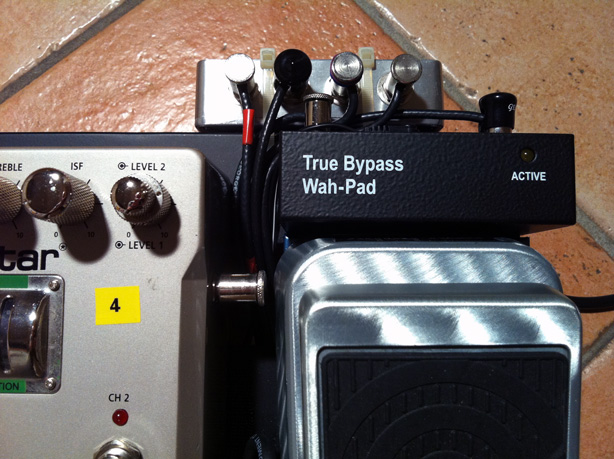
Fig 1: Close-up of I/O patch bay, G-Lab True Bypass Wah Pad and Dunlop Zakk Wylde Wah.

Fig 2: Polytune mini and AMT Legend Series P2 pedal. The Polytune is first in the signal chain and, being true bypass, doesn’t give any grief to the Dunlop Zakk Wylde Wah. Note that I’m using the “Drive Out” output of the P2 as Loop 1 will be run into the front-end of an amp/combo.
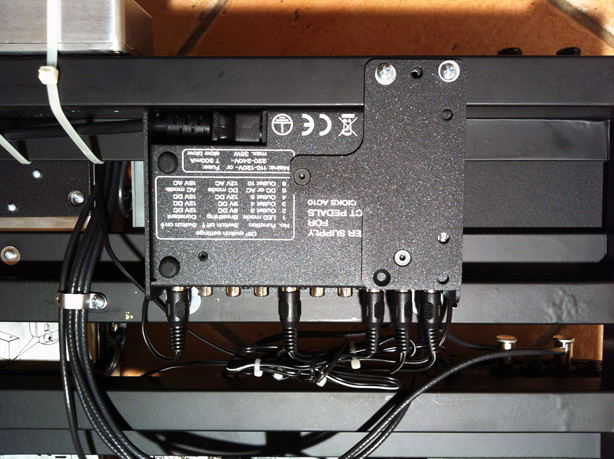
Fig 3: The Cioks AC-10 mounted below the PT Jr using its supplied mounting kit. I’m not a fan of self-tapping screws and therefore fitted Z-Nuts in appropriate places to mount the Cioks and provide some cable anchoring points.
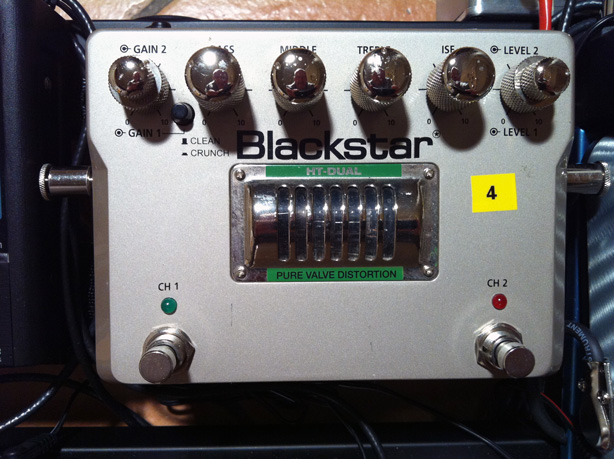
Fig 4: My trusty Blackstar HT-Dual (series 1), purchased in the UK a long time ago. Twin channels, giving me a heavy crunch for rhythm and heavy distortion for leads.
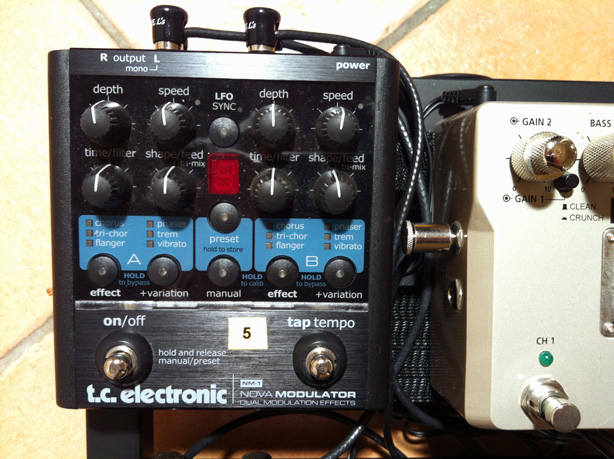
Fig 5: TC Electronics Nova Modulator. Frankly, a bit overkill for what I need, so this may well be replaced with a simple chorus pedal (with smaller form factor) in future. This, and the Nova Delay, are run in the board’s Loop 2 so that I can put these in the amp’s FX loop.
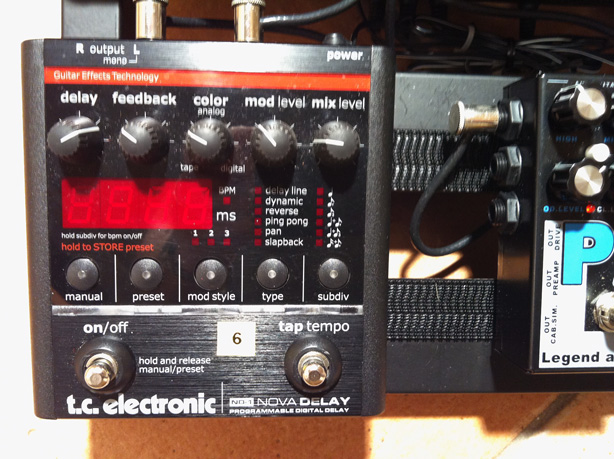
Fig 6: TC Electronics Nova Delay, placed in Loop 2. I love the great sounds and relative simplicity of use, although changing between the 9 user presets is not easy on the fly.

Fig 7: The G-Lab True Bypass Wah Pad has two mounting points underneath. Unfortunately, these are not ideally spaced for Pedaltrains, hence the additional bracket needed for the second mounting point (not shown here).

Fig 8: The Loopmaster patchbay is velcroed and cable-tied to the outside front rail of the Pedaltrain. Note also the additional taller PT feet (supplied with the Cioks mounting kit) needed to lift the back of the PT and provide enough clearance for the Cioks AC-10.
Some observations
Although this is a great board which covers the majority of sounds I need, there are a few negatives which means that I may well change a few things in the near future:
- I don’t really like the mounting system needed for the Cioks power supply. The taller feet, supplied in the Cioks mounting kit, add height to the board which, combined with the height of the G-Lab True Bypass wah pad and Zakk Wylde Wah, makes it a struggle to fit the loaded board into the PT softcase. With hindsight, the hard case option may be a better bet in this respect – but makes for a heavy thing to lug around.
- I’ll whisper this quietly: I’m getting a bit bored with the HT-Dual. After so many years of using my Dual Rectifier, I really miss that Mesa “Modern” heavy crunch, and much prefer the AMT P2 to the HT-Dual for general rhythm duty. However, if I ditch the HT-Dual, I’ll have to add a second distortion pedal for leads.
- Again, having got used to my MIDI-controlled Dual Rec and rack rig, I really miss one-touch preset changing. Tap dancing isn’t for me!
Overall, the board sounds great, is silent, with no buzzes, hiss or other nasties. I’m very pleased with it, though I’m not sure it will last long in its present incarnation…
Update
This pedalboard didn’t last long at all – just a matter of weeks – before I cannibalised it for the new Pedaltrain 2 board which will replace it. Why? Well, simply because I’ve decided to retire the Blackstar HT-Dual in favour of some new crunch/distortion pedals and, more importantly, want to go back to a MIDI-controlled system. Take a look at my Pedalboard 2013 – Pedaltrain 2 article to see what I am planning…
The Pedaltrain Jr will survive in another form, but at the moment only has the Nova Delay and Blackstar HT-Dual pedals for band rehearsals. More details soon…
